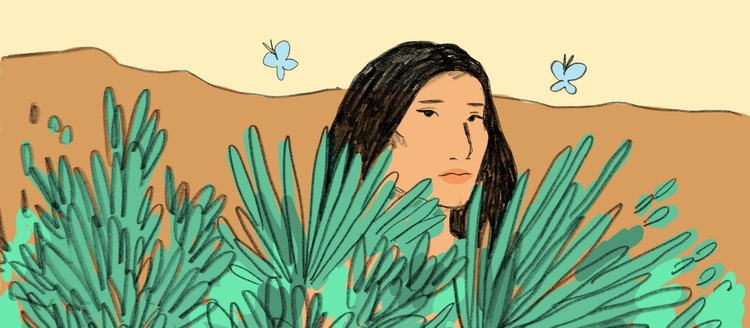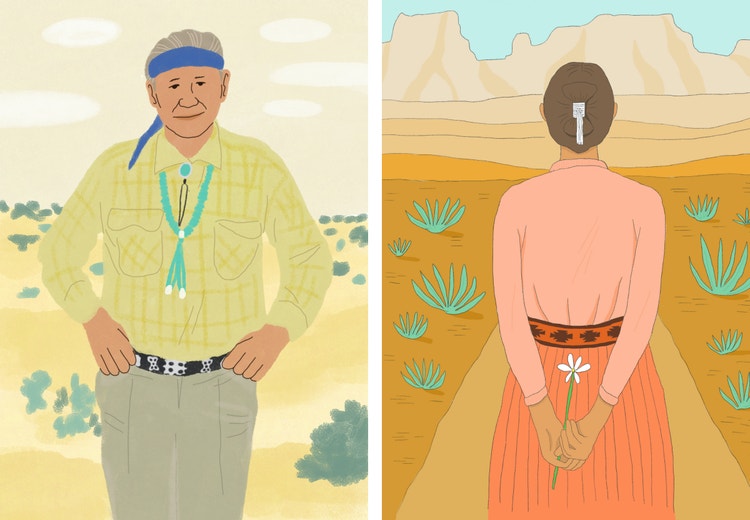Artist Lynne Hardy’s illustrations honor her family’s Navajo past, present, and future

Image credit: Adobe Stock / Lynne Hardy.
Adobe Stock contributor and illustrator Lynne Hardy’s artwork embodies the same principles she learned to live by from her grandmother Julia. From scenes of daily life and vast southwest landscapes to traditional Navajo crafts like weaving or building a hogan, Hardy’s illustrations are inspired by and convey a feeling of Hózhó.
“In the Navajo language, Hózhó means to walk in beauty and harmony,” explains Hardy. “And in Navajo culture, if you went out of harmony, you did certain ceremonies to bring you back. There are times when you need to be quiet. And there are some times where you need to listen to someone or listen to the earth or listen to the stories of your elders and how they could help you.”
Each illustration Hardy creates can be seen as an invitation for us to be still, listen, observe, and connect with stories older than us. It’s a powerful unifying vision that won her a commission for Adobe Stock, via the Adobe Stock Advocates program Artist Development Fund.
After graduating from college, Hardy has been busy investing in her skills and developing ways to pay the bills using her talents as an artist. The Artist Development Fund, a creative commission program Adobe Stock established in 2021, was open for applications, specifically seeking artists who self-identify with and depict diverse communities — including Native Americans — within their work. The Fund aims to provide meaningful support for artists to share creative visuals that express the personal narratives and first-person experiences of historically underrepresented communities.
“I was just browsing online and saw the Artist Development Fund application and I thought, ‘Hey, why not?’”
She recalls, “I thought it'd be cool to make these images, especially on such a wide scale, that so many people could use. I felt like the art needed to be seen, especially since Native American culture that can be so misrepresented sometimes.”
After a moment, she adds: “Actually, a lot of the time.”

Image credits (clockwise from top left): Adobe Stock / Lynne Hardy, Adobe Stock / Lynne Hardy, Adobe Stock / Lynne Hardy, Adobe Stock / Lynne Hardy.
Honoring the past and present
A lot of Hardy’s inspiration and drive comes from comparing her own life, and that from her friends and family, to the representations of Navajo and Native American life she sees most often.
“As a Native American you're told so many stories of the past and your culture, and you know, you're meant to keep it up,” says Hardy, who clearly loves and takes pleasure in keeping these stories and practices alive.
Among the hundreds of illustrations created during the last year, many feature traditional activities, objects, and folklore, from collecting pinion pine nuts and cooking frybread to sorting wool and silversmithing.
But Hardy isn’t someone living in days gone by: she’s a young artist living in contemporary America trying. “I'm like, ‘I can't go live in a hogan,’” says Hardy, “I do these modern things, but I'm still Native American, I still know what it's like to live without running water and without electricity.”
These two ways of life aren’t a kind of tension or discord in Hardy’s work — rather they form that harmony she’s always looking for. “I want to bring those two together and to show people that my art is not just relics of the past, but also something that you can be a part of, too,” she reflects.
So alongside her fond renderings of the traditions she’s inherited, Hardy created a whole constellation of scenes from her daily life: playing basketball, going for runs, lounging by the pool, and going for family road trips. Cumulatively, her portfolio manages to feel at once highly specific to her life and culture and universal to modern American life.
“I want people to look at it and feel happy. I want them to look at it and you know, feel like they can connect with it and with the colors,” says Hardy. To her, simultaneously bringing Native people into scenes of modern life and respecting their traditions visually is a way to honor both the lives they lead in 2022 and what it took for them to get here: “I guess it’s really about taking back my identity as a Native American.”

Image credits (clockwise from top left): Adobe Stock / Lynne Hardy, Adobe Stock / Lynne Hardy, Adobe Stock / Lynne Hardy.
Finding beauty in scenes of daily life
Growing up, Hardy was surrounded by artists. Her uncles created jewelry, her grandma made beads, and her uncle was a painter. She loved drawing from an early age and remembers always being encouraged by her parents. “They were just so nurturing. They’d hang up all the drawings I made and give me ideas like ‘go draw grandma hiking up a mountain,’” she remembers.
Despite her talent for and love of drawing, her path to where she is now wasn’t simple. Although she gravitated towards art classes in school, she always felt like she was blocked or something was missing. “I felt like I was kind of lost,” she recalls “but I think that’s what all artists go through. Like ‘who am I and what is the work I want to create and what is the message I want people to know.”
In retrospect, it’s unsurprising her artistic practice became alienated from her identity. Hardy recalls learning to feel ashamed of a lot of her Native American traits and features and values in public high school. She felt anxious about her nose or her cheekbones, features of Native women she now loves to celebrate in her drawings.
When it came time for her Kinaaldá, a Navajo coming of age ceremony, “I remember being so ashamed and so embarrassed, because people were like, why is her hair in her face? Is she something wrong with her?”
Even when she made it to college for illustration, something still didn’t click, “I hated every second of it. I hated going to class, I hated picking up my pencil,” she says “I was kind of distraught. I'm like, ‘I hate drawing now.’” It took her a transfer to another campus and a return to square one for her to find her groove again.
“I remember one day just lying there, thinking to myself, ‘when no one's watching, what do you draw?’” Hardy recalls “and then I just drew pictures of my grandma, or I drew pictures of Native American women I admire.” Just like when she was a child, these illustrations came easily and brought her joy. She continued drawing hogans and sheep and chopping wood and other things she knew intimately.
That’s when Hardy realized how much of her creative identity, craft, and message came from her heritage: “I know these things so well. I see it so much in the colors and textures. And I want to bring the modern, fresh take on it,” she says, “so I went from there, it kind of just started slowly building up to where I am now.”

Image credits: Adobe Stock / Lynne Hardy, Adobe Stock / Lynne Hardy.
Running together
After graduating, Hardy found jobs in illustration hard to come by. “I was just applying anywhere,” she says “I got a job working at a pizza shop. And as much as I like pizza, I was like, ‘I don't think I could stay here.’” She’d moved back from college in Hawaii to Utah where some of her family lives now.
Eventually, two of her sisters sat her down with a proposal: start their own business. At first it was a terrifying prospect; not having a regular income, not having the structural support of a large company, being responsible for everything yourself. But eventually, it became clear that the very values of mutual support, hard work, and living by your skills that they all grew up with were what it would take to start a business.
“Our business is called Ajoobaasani, which means ‘women from Gray Mountain’” says Hardy with ample pride. Hardy and her sisters Jenna and Leah work together to create cards, coloring books, comic books, and other designs and crafts that feature the same themes from modern Native American life.
While it’s no cakewalk owning your own business, Hardy sees parallels between it and the independence and freedom she learned from her grandmother. It’s the kind of freedom and peace and harmony that’s alluded to by Hózhó, where the act of walking is both a metaphor and a literal act.
“Grandma would say, you have to be ready for anything, you know, what if some emergency happens and you have to run somewhere, you have to carry your kids, your supplies... you gotta run,” Hardy remembers, “I remember how strong and fast she was, and how free she was. It just reminds me of how much my ancestors ran, how much they were in control of their bodies and how much they cared about.”
Hardy is an avid runner today – and always prepared.
Explore Lynne Hardy’s portfolio on Adobe Stock, and meet more recipients of the Adobe Stock Artist Development Fund.
Feeling inspired? Share your photography, vector art, illustrations, and videos through this year’s updated creative briefs, then contribute your best new work to sell on Adobe Stock.